Day 53: Renewable Energy IV—Water Power
Dear Student,
Humans have been harnessing water power to free us from heavy labor for millennia. These earliest machines were used to pump water or grind grains into flour.
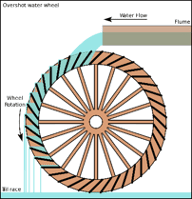 Later, water power was used to power saw mills and textile factories around the globe. Paddlewheels were the most common device for collecting power. By the start of the 1800s, most water-powered mills and factories had converted to steam power, and it would nearly another century until water power came back into common use with the invention of high-speed turbines.
Later, water power was used to power saw mills and textile factories around the globe. Paddlewheels were the most common device for collecting power. By the start of the 1800s, most water-powered mills and factories had converted to steam power, and it would nearly another century until water power came back into common use with the invention of high-speed turbines.
Today, if your water source is suitable, small-scale hydroelectric installations can be efficient, low cost ways of generating electricity for you homestead. Small streams are much less efficient than larger one, though, and smaller units will take longer to pay back their cost than larger ones.
Electrical generators do not operate at optimal efficiency until they reach 1,500 revolutions per minute (RPM). To reach these speeds using a water wheel, gears are needed to step up the revolutions of the generator. Using turbines to drive the generators avoids this problem by allowing faster turning by concentrating the flow of water and directing it at the blades at roughly a 170-degree angle. There several commonly used types…
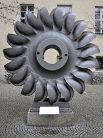
Pelton Wheel Turbines: This turbine directs the water underneath the wheel to drive it from below. These older model turbines operate best when there is a head of 50 feet or more and their runners (blades) vary from 3 to 24 inches for home installations. (Head is the height difference between where the water enters into the system and where it leaves. The more head you have the higher the water pressure across the hydro turbine and the more power it will generate.)
Cross Flow Turbines: These can operate with only 3 feet of head and are fairly easy to construct at home if you have some metal working skills and tools.

Propeller Turbines: These are completely submerged in a horizontal flowing 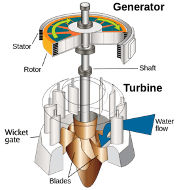 pipe of water and operate best with heads of 3 to 30 feet.
pipe of water and operate best with heads of 3 to 30 feet.
Francis Turbines: These are similar to propeller turbines but the water enters from above and gravity assists the head pressure. These turbines work efficiently with heads over 4 feet and are the most effective.
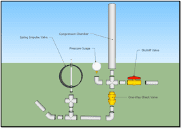 Hydraulic Ram Pumps: Not a turbine, but these are incredibly useful water-powered pump systems if you have the right geography and access to suitably flowing water. Simply put, this system uses the force of the water flowing through it to pump a portion of this water higher than the head it comes from. Efficient ram pumps can drive water six times the height of the head.
Hydraulic Ram Pumps: Not a turbine, but these are incredibly useful water-powered pump systems if you have the right geography and access to suitably flowing water. Simply put, this system uses the force of the water flowing through it to pump a portion of this water higher than the head it comes from. Efficient ram pumps can drive water six times the height of the head.
Is Your River Suitable?
You can calculate the cost/benefit of installing your own system by checking how much hydropower potential your stream has, and it should be surveyed several times in a year to give you an average.
Hydropower potential is calculated by using the head height, velocity, and cross-sectional area of the stream bed.
Calculating The Head
The head is the vertical drop between where the water is diverted from the 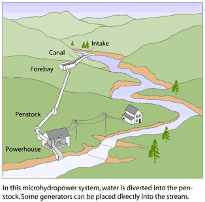 stream to where it enters the turbine. In hilly areas the head will be bigger. Head height might be found in public records, but if not, you can determine it for yourself by using a surveyor’s level or with a hose.
stream to where it enters the turbine. In hilly areas the head will be bigger. Head height might be found in public records, but if not, you can determine it for yourself by using a surveyor’s level or with a hose.
Checking the head height with a hose requires two people. Take a long, preferably clear plastic hose and go to the water source where you propose to divert the stream.
Fill the hose with water until full and hold both ends up. With your assistant holding the other end of the hose, walk your end of the hose downhill with you holding your end up as he slowly drops his end to ground level (until it is just about to spill a little on your end). Stop walking.
If you don’t have a clear hose, have the hose topped up again until it is full. Measure the height the top water level is from the ground. This is the head to this point. Repeat this process until you reach the site of the proposed power generation house.
Calculating The Velocity
Measure out a length of stream (say 50 feet for this example). Drop a buoyant item into the river and time how long it takes to cover the distance (say 200 seconds).
Velocity (V) is Distance (D = 50 feet) divided by the time figure (T = 200 seconds).
V = D/T= X feet per second
V = 50/200 = 0.25 feet per second
Make a provision for underwater drag (20%).
V = (D/T)*0.8
V = (50/200) x 0.8 = 0.20 feet per second
This figure is your average velocity per second.
Calculating The Cross-Section Area
Take some string, rope, or a long measuring tape across your stream and measure depths at even intervals (10 is a good number for larger streams).
Add these numbers together and divide by the number of measurements and this will give you the average depth.
Multiply the average depth by the width of the stream and this gives you the area of the cross section (A).
Volume of flow = Velocity * Area = CFS (cubic feet per second of flow)
Repeat this process at several different times of year to get the annual average.
Efficiency
This is how well your generator converts the kinetic energy into electricity. Older models run at about 60% and newer models run up to 90% efficiency.
Potential Hydropower Available Per Hour
Kilowatts of power = Head (feet) * Cubic feet per second (CFS) * Efficiency (75%)
Divided by 11.8
Does It Make Economic Sense?
Unless you are able to sell excess power to the grid or can partner with a close neighbor for a shared system, you will have to size your system for your own needs.
There are economies of scale here, so if you have the volume of water necessary for a larger system than you currently require, consider putting a little more into a larger system for use as your homestead grows in productivity.
Review your current utility bills or an online power usage estimator to calculate your current spending on power and determine what you will need over the next few years. Get a quote from a hydropower installer for a system to run your requirements and calculate how long it would take to repay the savings compared to other options (like grid-tied solar systems). And take into account the fact the electrical costs will rise over time…
If the payback period is too long to make sense financially, consider going with solar or other off grid options.
Dams And Water Impoundments
Dams or ponds on your property always increase productivity…
You can eliminate the problem of inconsistent flow rates of a stream or river by capturing and impounding water on your property from rainfall and the stream itself.
If you impound water high on your property, it can be stored until you need it for power during low rainfall times.
